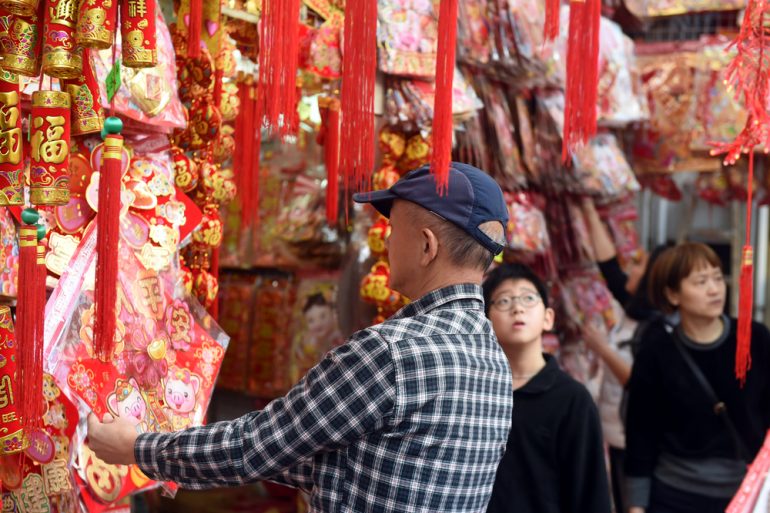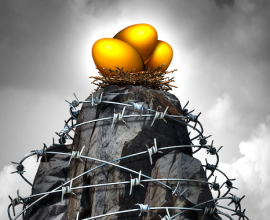What is so important about the Chinese New Year?
There are at least three reasons why the Chinese celebrate the New Year: one concerns a terrifying monster. The other is the winter solstice. The third is, by far, the most important. Read on…
The Chinese New Year falls on Tuesday, February 5.
This year could be the 3,80oth time Chinese New Year is being celebrated; probably more, some historians say. Because Chinese culture is one of the oldest in the world, the origins of the Chinese New Year is lost in the mists of time.
The first reported fragments of history indicate that the Xia Dynasty ruled China between c. 2070 to c. 1600 BC.1 Sima Qian, the Chinese historian in Records of the Grand Historian, and the Bamboo Annals
Written records of Chinese history go back to some 4,000 years.
The Shang Dynasty ruled in the Yangtze-kiang valley between 1600 and 1046 BCE.2William G. Boltz, Early Chinese Writing, World Archaeology, Vol. 17, No. 3, Early Writing Systems. (Feb., 1986), pp. 420–436 (436)
The Yangtze-kiang has several names. One is ‘Yellow River’. It derived its colour from the sediment it carries. Historians consider the Yellow River Valley to be the cradle of Chinese civilisation.
Incidentally, does the 1970 song ‘Yellow River’ by the British band Christie, trigger any memories in the older readers?
There are several reasons why the Chinese celebrate the Chinese New Year
One reason outweighs all others.
We’ll get to that in a minute.
We will first deal with two.
Legend of the Nian3https://www.thatsqingdao.com/chinese-new-year-history-legend-nian/
In this mythological account, long, long ago, there lived, high in the mountains, a ferocious, carnivorous monster.
It was the Nian.
It had the body of a bull and the head of lion. It was a hunter.
As winter grew, and game diminished, the Nian monster descended from the mountains into the villages.
It devoured men and livestock.
This grew to be an annual habit. The villagers lived in fear.
Over time they realised that the Nian monster was afraid of three things: the colour red, fire, and noise.
Villagers banded together to prepare their defences; and lay in wait.
When the Nian next descended upon the villages, the villagers placed a bonfire before the door of every home. They hung a red board before each door. Bamboos were cut and thrown into the fire. They made a loud explosive sound. The people stayed up the night, and made a great deal of noise.
The combination of these strategies struck the monster with fear.
It fled into the mountains. It never returned.
Obviously, this victory called for a great celebration.
And so the ritual of fire, red painted boards and loud noises were kept up each year, until these celebrations blossomed into the Spring Festival.
The memory of the celebration has been passed down the generations, even to this day.
Thus was born, it is said, the custom of Guo Nian (过年).
That is the legend.
Could there be another reason?
Calendars of the Moon and the Sun
Some civilisations used the movement of the earth around the sun as the basis of their calendars: this was based on solar time.
The Chinese measured time using the moon. This is also known as sidereal time.
Winter Solstice – how the Chinese calculate the date of the Chinese New Year
The Chinese New Year is based on the winter solstice.
A solstice which occurs when the Earth’s axis is tilted away from the Sun. Astronomers call it the ‘winter solstice’. In the Northern Hemisphere, the last Winter Solstice occurred 21 December, 2018 at 22:22 UTC. This year it will occur on 22 December, 2019, at 04:19 UTC.
The winter solstice marks a time when nights get longer, and the days grow shorter.
The reason we speak of all of this astronomical mumbo jumbo is because it is related to the second reason why Chinese New Year is celebrated.
A Farmer’s Almanac – the agrarian calendar
The second reason for the celebration has to do with agriculture.
The old Chinese word “Nian” means “ripe grains”. This word was found in oracle bone inscriptions along with astronomical records during the 14th century BC, dating to the Shang Dynasty (1600-1046 BCE). These were more than 3000 years old.
The sole purpose of having a calendar, historians find, was to keep track of time to help agriculture. It was important for farmers to know when to till the soil, when to sow the seeds; and when to harvest. Getting their time right helped the farmers organise their agricultural activities.
It thus became the principal duty of the Chinese monarch to fix the date of the Winter Solstice day. In this the Emperor had expert help. Scholars in astronomy, fixed and predicted the date of the Winter Solstice. Taking the winter solstice as the starting point, the Chinese experts calculated forward to the first day of the second new moon. Over thousands of years of practice, this day was celebrated as the Chinese New Year (農曆新年, Nónglì Xīnnían); or the Lunar New Year. It is the most important of the traditional Chinese holidays.
To keep Heaven and Earth in harmony, on that day the Emperor performed traditional rituals, offered prayers and selected the music to be played for the season.
The Chinese lunar calendar is similar to the western Farmer’s Almanac.
The Spring Festival Holidays
The Chinese New Year holidays, called the ‘Spring Festival,’ start on the 23rd or 24th day of the 12th month of the lunar calendar. They end with the Lantern Festival which occurs on the fifteenth day of the first month of the Lunar New Year (which is a full moon).
The Fifteen days’ Celebrations
I still remember a cartoon by Lat. A couple of rodents feast on a deserted road – usually the busiest in Kuala Lumpur – during Chinese New Year holidays. This was because no commerce moved on the first fortnight of the holiday season – except for pre-determined days.
On the first day of the celebration the people welcome the deities of heavens and earth.
This begins at midnight – and always with a bang.
It is traditional to light up fireworks, burn bamboo sticks and make a great deal of noise. This is believed to rid one’s home of evil spirits.
Some people consider lighting fires and using knives on the first day to be bad luck. So food is pre-cooked.
On this day children visit, and pay their respects to the most senior member of the extended family.
A dragon’s dance
A lion dance troupe goes about town. The dance of the Red Dragon is a combination of movement, music, and acrobatic skill. Two youths make up the body of the dragon. They exhibit their martial prowess to the lively beat of the Chinese drum and the cymbals. When their exertions comes to an end, shop owners place a package containing money into the dragon’s ‘mouth’. It brings good luck.
Married family members hand out red envelopes containing cash. This is usually in even-numbered denominations. The numbers 8 and 6 are considered particularly auspicious.
On the second day, married daughters visit their parents and relatives.
The fourth day is the corporate day. Traders open up their shops for a little while to usher in good luck.
Driving away the Ghost of Poverty
On the sixth day the Ghost of Poverty is banished by throwing out garbage. I have often noticed Chinese friends exhibiting a strong disinclination to sweep their homes during the celebrations. When things got a little untidy during the first five days, household debris was carefully swept and kept in a corner. It was not discarded until it was time: for good luck would depart, it was said.
Who could do without Yee Sang?
The seventh day is celebrated by having a dinner comprised of a salad of raw fish – Yusheng (魚生) or Yee Sang.
The eighth day is to celebrate the eve of the birth of the Jade Emperor, the Ruler of Heaven. On this day people return to work. Business owners host lunch for their employees, possibly as a sign of appreciation.
Lantern Festival
On the Fifteenth Day is the Lantern Festival (“Yuanxiao Festival”). Lanterns are lit so that lost spirits can be guided home.
In the night, family members and delighted children parade the streets bearing lighted lanterns. And the lanterns are of many shapes and colour.
Chap Goh Mei and Etherton
In some places this is also the day for what is known as Chap Goh Mei (十五暝).
On this day, single women seek romantic liaison by casting mandarin oranges into a river. Unmarried men scooped them up to taste.
A sweet-tasting orange represents good luck, and a good bride.
Sour fruits did not.
Half a century ago, I remember a school textbook. It was called English Comprehension. A.R.B Etherton had written it as a Teaching Aid for Malayan schools. He filled its pages with local stories and customs.
Under ‘Chinese New Year’, were captioned the words Chap Goh Mei.
A cartoonist’s impression shows a group of giggling young ladies lobbing oranges into a river.
On the far side sits a man upon a sampan. Half his face his hidden below a conical hat.
With a fishing pole, he reels in the fruits: an Englishman’s idea of an old custom.
It brings back a flood of memories.
These days, I am told, young ladies write their mobile phone numbers on the oranges.
And the Third Reason
New Year’s Eve is the day of the Reunion Dinner. Family members gather at the home of the most senior member of the clan for an elaborate meal.
Time marches on.
This night, like 4,000 identical nights of the past, sees old customs giving way to the incessant bustle of modern life.
The aged cast a wistful glance at an empty nest. All their children are gone.
Tonight, though, is special; as is every night this fortnight.
It affords an opportunity for our ethnic Chinese friends to return home to honour their parents and elders.
The fundamental principles of Chinese culture are respect for tradition, the honouring of elders, and the love of family.
What could be more important than these?
From all of us at GK Ganesan and the Paradox team, Happy Chinese New Year! May you have a wonderful, prosperous, joyful year ahead!
Here are our wishes for you. Take your pick!
金玉滿堂 Jīnyùmǎntáng = “May your wealth [gold and jade] come to fill a hall”
大展鴻圖 Dàzhǎnhóngtú = “May you realize your ambitions”
迎春接福 Yíngchúnjiēfú = “Greet the New Year and encounter happiness”
萬事如意 Wànshìrúyì = “May all your wishes be fulfilled”
吉慶有餘 Jíqìngyǒuyú = “May your happiness be without limit”
竹報平安 Zhúbàopíng’ān = “May you hear [in a letter] that all is well”
本萬利 Yīběnwànlì = “May a small investment bring ten-thousandfold profits”
福壽雙全 Fúshòushuāngquán = “May your happiness and longevity be complete”
招財進寶 Zhāocáijìnbǎo = “When wealth is acquired, precious objects follow”





